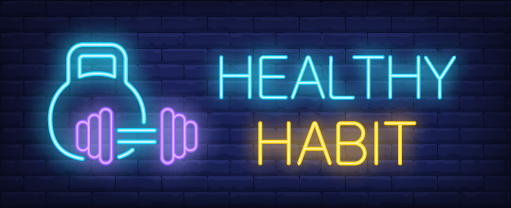How To Make (and Keep) Healthier Habits

Healthy habits include anything you do to benefit your physical, mental or emotional well-being. They help create a healthy life. If you are not used to living a healthy lifestyle, these habits can be difficult to develop.
Change is hard! However, if you are ready to commit to improving your health, creating healthier habits is possible and will greatly benefit you in the long run.
Why a habit? Habits free us from decision making and from relying on self-control. According to researchers at Duke University, habits account for about 40 percent of our behaviors on any given day.
Once something is a habit, it becomes almost automatic and you do it without thinking. A habit is formed through a habit loop consisting of a cue, an activity and a reward. Something cues you to complete a certain activity like a location or time of day.
When that activity is complete your brain releases chemicals (like dopamine) that signal pleasure. Because of the reward, your habit loop is reinforced. This reward can feel like stress relief or happiness or another benefit that feels good to you at that moment.
Your brain will want to complete that activity again next time it is cued so you will receive the reward. This works for all habits, healthy ones and bad.
For example, say whenever you get ready for bed (cue), you brush your teeth (activity), which results in clean feeling teeth that makes you feel good (reward).
Or a bad habit, whenever you drive to work (cue) you stop by Starbucks and get a Venti Mocha Frappuccino (activity) on your way in and you are rewarded by that rush of sugar (reward).
Do you have some unhealthy habits you want to break? Think of the habit loop.
A habit starts with a cue. Because bad habits serve you in some way, it’s very difficult to simply eliminate them. Instead, the activity you would like to stop needs to be replaced by a new habit that provides a similar benefit or reward.
Let’s say you want to quit smoking. What cues you to smoke? Identify your triggers and replace the bad habit with a healthier one whenever that cue comes up that will elicit a reward/similar benefit.
If you normally go outside on your work breaks (cue) for a cigarette, ask a coworker to go for a walk with you instead. Or, if possible, remove those cues that make you want to smoke. Another example, if you would like to stop snacking in the evening after dinner, think of what cues you to do so.
If it is sitting and watching tv, switch the mindless munching to knitting or doodling. Or remove the cue of watching tv by meeting up with a friend instead or talk on the phone. Cut out as many cues as possible. If you can’t remove the trigger, replace the unwanted activity with a healthier option.
James Clear said, “When you learn to transform your habits, you can transform your life.”
Here are three more ways to create and keep whatever healthy habits you want to start.
- Add a healthier behavior to an existing habit. You brush your teeth every day right? It’s automatic (because it is a habit!). Try adding an action you want to make a habit at the same time as one of your existing habits.
For example, if you want to eat more vegetables you don’t have to necessarily completely change your normal eats. If you normally make eggs for your breakfast start adding spinach to them to get more vegetables.
Or if you need to drink more water, add filling your water bottles for the next day to the time you normally brush your teeth before bed. Put your water bottle right next to your tooth brush so you will remember. Then your water bottles are ready to go the next morning. Pretty soon when you go to brush your teeth, filling your water bottles will just be part of the routine. Do you drive by the gym on your way home from work? Make it a new stop on your usual drive home. Before you know it, going to the gym after work will be automatic.
- Start Slow. You wouldn’t go out and run a marathon if you’ve never run a mile. Make small changes (a few or even just one at a time) and slowly add more from there. This goes for anything, including both exercise and nutrition. It is important to make SMART goals. (Check out my post about SMART goals here!) The R stands for realistic. Setting small, measurable, realistic and time measured goals will help you reach a bigger milestone and keep you motivated along the way. If you are new to exercise, a SMART goal, or habit to start, may be to go to the gym twice this week. Or to take a walk for 20 minutes three times this week.
It can be easier to make changes to your nutrition slowly as well. Eating healthfully should be lifelong, not just for 21 or 30 days. A SMART goal to start eating better could be to cook at home three nights this week if you usually go out or get take out every night.
Or pack your own lunch if you normally go out. If you drink soda, replace it with water or unsweetened tea. As you get used to these changes and they become habit, you can add more.
- Pause, don’t stop. In her book “Better Than Before”, Gretchen Rubin says restarting is harder than starting. If you derail from your new exercise routine or healthier eating, take a step back and pause. Don’t think all is lost because you missed a few days of your new habits. You didn’t stop, you just paused and are able to start right back up where you left off. This happens to everyone and it will to you as well. So plan for it and know what you will do when you do get off track. Building healthier routines is not all or nothing, and missing a week or workouts or one weekend of unhealthy eats doesn’t make you a failure. It makes you human and you can start right back where you left off.
Not sure what kind of healthy habits to adopt? Here are a few things that might be a good fit in your daily routine. You don’t have to do all of these suggestions, some of them you might already be doing, plus it’s better that you don’t try too many new things at once. As we already discussed, start small and pick one or two things to turn into a new habit then build from there!
- Drink More Water – Track your water intake with an app like My Fitness Pal. Drinking one full glass of water before every meal is a great start and a great habit to implement!
- Walk during every break you have at work or aim walk for 2-5 minutes every hour
- Strength train two times a week
- Take the stairs instead of the elevator whenever possible
- Turn off all electronic devices at least an hour before bed
- Keep a Sleep Schedule – go to bed and wake up at the same time each day
- Be Mindful – Stay in the present moment, whatever you are doing. This could be meditation or simply focusing on the task at hand. Pay attention to your breathing and all the sensations you are experiencing.
Change can be hard. Be patient, give yourself some grace and keep reminders around of why you want to create this healthier life.
“Habits are the invisible architecture of daily life. We repeat about 40 percent of our behavior almost daily, so our habits shape our existence, and our future. If we change our habits, we change our lives.”
― Gretchen Rubin, Better Than Before: Mastering the Habits of Our Everyday Lives
Topics: LivRite News


